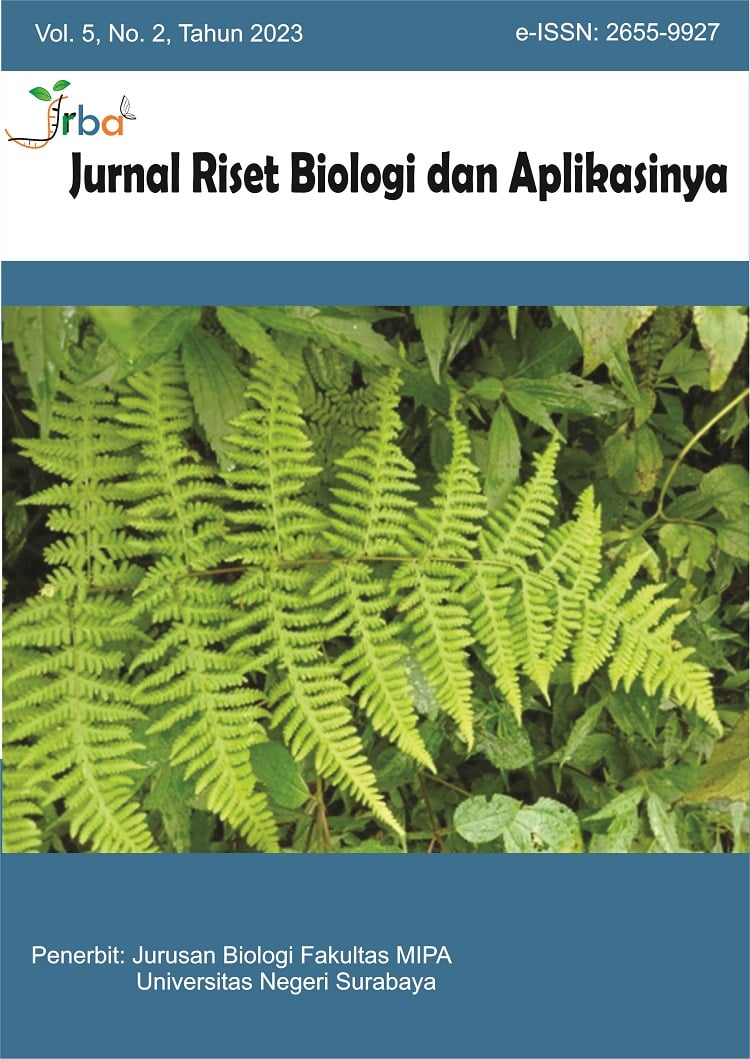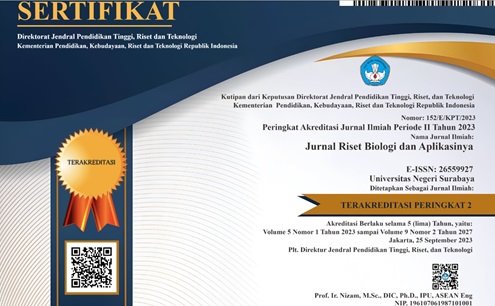Exploration and Identification of Endophytic Molds on Leaves and Stem of the Mango’s Mistletoe (Dendrophthoe Pentandra (L.) Miq)
DOI:
https://doi.org/10.26740/jrba.v5n2.p79-88Abstract
Mango’s mistletoe is one of the herbal plants’ rich in bioactivity. Secondary metabolites are not only produced by plants but also by microorganisms that live in tissues. One of these microorganisms is endophytic mold. The ability of endophytic molds to synthesize secondary metabolites is an opportunity for large-scale production in a short time without causing the exploitation of natural materials. This research aimed to explore and identify endophytic molds from the leaves and stem of the mango mistletoe to obtain the genus of molds. The stages of this research consisted of isolation by direct planting with sterilization, purification, growth rate measurement, characterization, and identification carried out macroscopically and microscopically. DBM 1 and DBM 2 belong to Aspergillus sp., DBM 3 belongs to Cladosporium sp., DBM 4 belongs to Neurospora sp., TDBM 1, TDBM 2, and TDBM 3 belong to Hormiscium sp. The growth rate of Aspergillus sp. relatively fast, with the increase in diameter of Aspergillus sp.1 colony from 2.45 cm to 5.05 cm and that of Aspergillus sp.2 from 2.73 cm to 5.35 cm. In the Cladosporium sp., there was an exponential phase with an increase in diameter from 2.15 cm to 4.65 cm. In Neurospora sp., there was an exponential phase with an increase in diameter from 0.63 cm to 3.65 cm. The growth rate of Hormiscium sp. is quite fast, with an exponential phase with an increase in the diameter of the colonies of Hormiscium sp.1 from 2.63 cm to 7.21 cm, Hormiscium sp.2 from 2.45 cm to 6.94 cm and Hormiscium sp.3 from 2.85 cm to 7.85 cm.
References
Agrios, G. N. (2005). Plant Pathology 5th Edition. New York: Elsevier Academic Press
Barnett, H.L and B.B Hunter. (1998). Illustrated Genera of Imperfect Fungi Fourth Edition. USA: APS Press
Fenita Y, Santosa U., & Prakoso. (2010). Pengaruh Suplementasi Asam Amino Lisin, Metionin, Triptopan, dan Ransum Berbasis Lumpur Sawit Fermentasi Terhadap Performa Produksi Dn Kualitas Telur Ayam Ras. Jurnal Sains dan Peternakan Indonesia, 5, 105-114. https://doi.org/10.31186/jspi.id.5.2.105-114
Gandjar, I., Samson, R.A., Veurmeuleun, K. V. T., Oetari, A dan Santosa, I. (1999). Pengenalan Kapang Tropik Umum. Jakarta: Yasasan Obor Indonesia
Hasanuddin. (2003). Peningkatan Peranan Mikroorganisme Dalan Sistem Pengendalian Penyakit Tumbuhan Secara Terpadu. Sumatera Utara: Universitas Sumatera Utara
Hidayati, N. (2010). Isolasi dan Identifikasi Jamur Endofit Pada Umbi Bawang Putih (Allium sativum) Sebagai Pengahsil Senyawa Antibakteri Terhadap Bakteri Streptococcuc mutans dan Escherichia coli. Skripsi. Malang: Jurusan Biologi Fakultas Sains dan Teknologi Universitas Islam Negeri Malang (UIN) Maulanan Malik Ibrahim
Kasi, Y.A. (2015). Uji Efek Antibakteri Jamur endofit Daun Mangrove Avicennia marina Terhadap Bakteri Uji Staphylococcus aureus dan Shigella dysentriae. Jurnal e-Biomedik, 112-117. https://doi.org/10.35790/ebm.v3i1.6632
Matitaputty., Nurfaizin. (2015). Penggunaan Kapang Karotenogenik Neurospora dalam Fermentasi Limbah Pertanian Untuk Pakan Ternak Unggas. Wartazoa, 17 (4), 189-196. http://dx.doi.org/10.14334/wartazoa.v25i4.1229
Miyashira, C.H., Tanigushi D.G., Gugliotta A, M., Santos D.Y.A.C. (2010). Comparison of Radial Growth Rate of the Mutualistic Fungus of Attasexdens rubropilosa forel in two culture media. Brazillian Journal of Microbiology, 41, 506-511. 10.1590/S1517-838220100002000035
Molina, Pimentel M, Bertucci T, Pastore G. (2012). Application of Fungal Endophytes in Biotechnological Processes. The Italian Assotiation of Chemical Enginering, 27, 289-294. 10.3303/CET1227049
Mukhlis, D. K., Rozirwan dan Hendri, M. (2018). Isolasi dan Aktivitas Antibakteri Jamur Endofit Pada Mangrove Rhizophora apiculata dari Kawasan Mangrove Tanjung Api-Api Kabupaten Banyuasin Sumatera Selatan. Maspari Journal, 10(2), 151-160.https://doi.org/10.56064/maspari.v10i2.5899
Murdiyah, Siti. (2017). Fungi Endofit Pada Berbagai Tanaman Berkhasiat Obat di Kawasan Hutan Evergreen Taman Nasional Baluran Dan Potensi Pengembangan Sebagai Petunjuk Praktikum Mata Kuliah Mikologi. Jurnal Pendidikan Biologi, 3 (1), 64-71. http://repository.unej.ac.id/handle/123456789/80415
Oktaviana, N.A., Athiroh, N., dan Mubarakati, N.J. (2021). Effect of Mistletoe (Tea and Mango) Extract Combination on Histopatological Profile of Brain in Hypertensive Rats. Jurnal Biologi dan Pendidikan Biologi, 14(1), 22-33.https://doi.org/10.20414/jb.v14i1.339
Radji. (2005). Peranan Bioteknologi dan Mikroba Endofit Dalam Pengembangan Obat Herbal. Ilmu Kefarmasian, 2 (3), 113-126. http://dx.doi.org/10.7454/psr.v2i3.3388
Rante, Taebe B dan Intan S. (2013). Isolasi Fungi Endofit Penghasil senyawa Antimikroba Dari Daun Cabai Katokkon (Capsicum annuum L Var. Chinensis) dan Profil KLT Bioautografi. Farmasi dan Farmakologi, 17 (2), 39-46.http://repository.unhas.ac.id:443/id/eprint/11040
Sia, Marcon J, Luvizotto D. M., Quicine M. C., Pereira C. O., Azevedo J. L. (2013). Endophytic Fungi From The Amazonian Plant Pullinia cupana and from Olea europea Isolated Using Cassava as an Alternative Strach Media Source. Springer Plus, 2 (579), 1-9 https://springerplus.springeropen.com/counter/pdf/10.1186/2193-1801-2-579.pdf
Sitanggang, J.M., Siregar E.B.M., & Batubara R. (2016). Respon Phaeophleaospora sp. Terhadap Fungisida Berbahan Aktif Metiram Secara In Vitro. Peronema Forestry Science Journal. 5(3): 147-152
Suhartina, F.E. 2018. Isolasi dan Identifikasi Jamur Endofit Pada Tumbuhan Paku (Asplentum nidus). Jurnal Mipa Unstrat Online, 24-28. http://ejournal.unsrat.ac.id/index.php/jmuo
Suniti, N., Sudarma. (2016). Uji Daya Hambat Jamur Endofit dan Eksofit Dalam Menekan Pertumbuhan Fusarim oxysporum f.sp. valillaePenyebab Busuk Batang Panili Secara In Vitro. Agrotrop, 6(2), 137-145. https://ojs.unud.ac.id/index.php/agrotrop/article/view/29441
Suryanti, I.A., Y. Ramona dan Proborini. (2013). Isolasi dan Identifikasi Jamur Penyebab Layu dan Antagonisnya Pada Tanaman Kentang Yang Dibudidayakan di Bedugul, Bali. Jurnal Biologi, 17 (2), 37-41. https://ojs.unud.ac.id/index.php/bio/article/view/12065
Wahyuni, Siti H. (2015). Identifikasi Dan Uji Antagonisme Jamur Endofit Tanaman Tebu (Saccharus officinarum) Terhadap Perkembangan Xanthomonas albilineans L. Dengan Metode Sterilisasi Autoklaf dan Membran Filter. Tesis. Medan: Fakultas Pertanian Universitas Sumatera Utara
Wicaksono. (2013). Potensi Fraksi Etanol Benalu Mangga (Dendrophthoe petandra) Sebagai Agen Anti Kanker Kolon Pada Mencit (Mus musculus Balb/c) Setelah Induksi Dextran Sulvat (DSS) dan Azoxymethane (AOM). Biotropika, 1(2), 75-79. https://biotropika.ub.ac.id/index.php/biotropika/article/view/169/123
Downloads
Published
How to Cite
Issue
Section
License
Copyright (c) 2023 Jurnal Riset Biologi dan Aplikasinya

This work is licensed under a Creative Commons Attribution-NonCommercial 4.0 International License.
 Abstract views: 281
,
Abstract views: 281
, PDF Downloads: 392
PDF Downloads: 392












